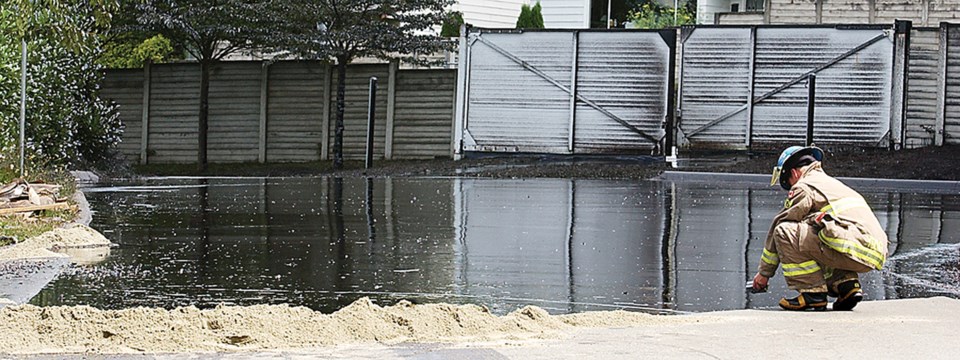It was lunch hour on a gorgeous summer day, much like the ones Burnaby has been enjoying recently.
Mary Hatch was reading in her kitchen with its postcard-perfect view of Burrard Inlet, oblivious to the chaos going on behind her on Inlet Drive.
About one o’clock, a firefighter banged on her door telling her to evacuate because an oil pipeline on Inlet had been ruptured by a construction crew.
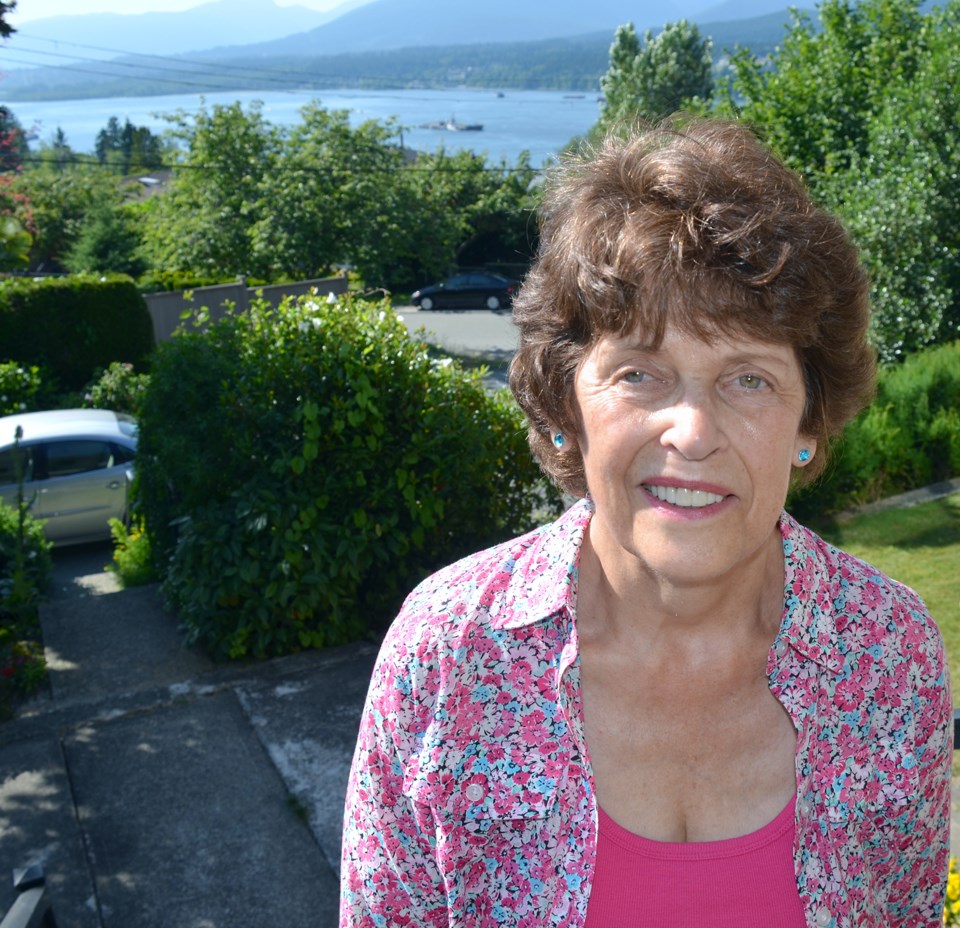
The news caught her entirely off guard. She couldn’t wrap her head around what he was saying. Hatch had no clue there was an oil pipeline running so close to the home she’d lived in since 1976.
“When the firefighter came and told me I had to evacuate immediately and said there had been an oil spill, I had no idea what that meant,” says Hatch a decade later.
She soon found out.
Excavator hits pipeline
According to a Transportation Safety Board (TSB) report, at 12:31 p.m., on July 24, 2007, a 24-inch pipe was punctured by an excavator.
A construction crew contracted by the City of Burnaby was working on Inlet Drive about 100 metres from Hatch’s home. The rupture was to a pipeline supplying crude oil from the Kinder Morgan tank farm on Burnaby Mountain to the Westridge dock on Burrard Inlet. The oil sprayed for about 25 minutes, said the report, before the flow was halted.
‘One of the hardest days’
“It was one of the hardest days of my entire career,” says Lambert Chu, Burnaby’s city manager.
At the time, Chu was the city’s chief engineer. He was just heading out to check a work site when he got a call from his office at 12:45 p.m. informing him an oil pipeline had ruptured on Inlet Drive. Hearing “oil pipeline” and “rupture” in the same sentence was a red flag alerting him to the dire seriousness of the situation. He did have a clue. Chu immediately made a detour and was on site 10 minutes later.
“That was a scene I will never forget,” Chu says. “It was crude oil, and it was very heavy and black. It was as black as you could imagine, shooting up into the sky, at least 30 feet high spraying onto the roads and property, the landscaping and the trees all in a close vicinity. The whole road was just covered in black oil, and so were some of the fences and yards.
“That was a scene that is hard to forget. You only see that in movies.”
Something was terribly wrong
As soon as the geyser started spewing from the punctured pipe on Inlet, Rob Hadden’s cellphone bleeped. It was a text from Earl, which is what Kinder Morgan called its Emergency Response Line (ERL) at Kinder Morgan’s control centre.
It notified Kinder Morgan managers, which included Hadden, who was based in Burnaby. ERL had them all scrambling with the notification that something was terribly wrong.
Although there was a lot of unknowns at that moment, Hadden realized the significance of ERL’s message right away.
‘It was surreal’
Hatch, a retired teacher, figured she’d grab her purse and some paperwork and go up the coffee shop until it was all over. But when she went down the stairs of her sundeck everything was covered in oil.
“I could make no sense of this,” she says. “I had no idea where it came from. It was surreal actually.”
Hatch hopped into her cream-coloured car. At least it had been cream-coloured. It was now black. She could barely see out the windshield. She learned later it wasn’t a good idea to be driving a car during an oil spill. You weren’t even supposed to be turning on an engine for fear of sparking a fire.
But she did. She went directly to a carwash at Hastings and Fell. They told her they couldn’t deal with it, but did clean off her windshield.
“Then, and this is how my mind worked, I decided to go to ICBC. They hadn’t heard anything about this, and they sent me away. But I reported what had happened. I didn’t know where I was supposed to go, what I was supposed to do,” says Hatch.
What she did do is go to the doggy day care where her 75-pound Labradoodle Goldie was. “I realized my dog couldn’t come back.”
She told her son Tom, who was taking summer school at Burnaby North, and daughter Gloria, who was interning downtown, to meet her there. Together they began to grasp the seriousness of the situation.
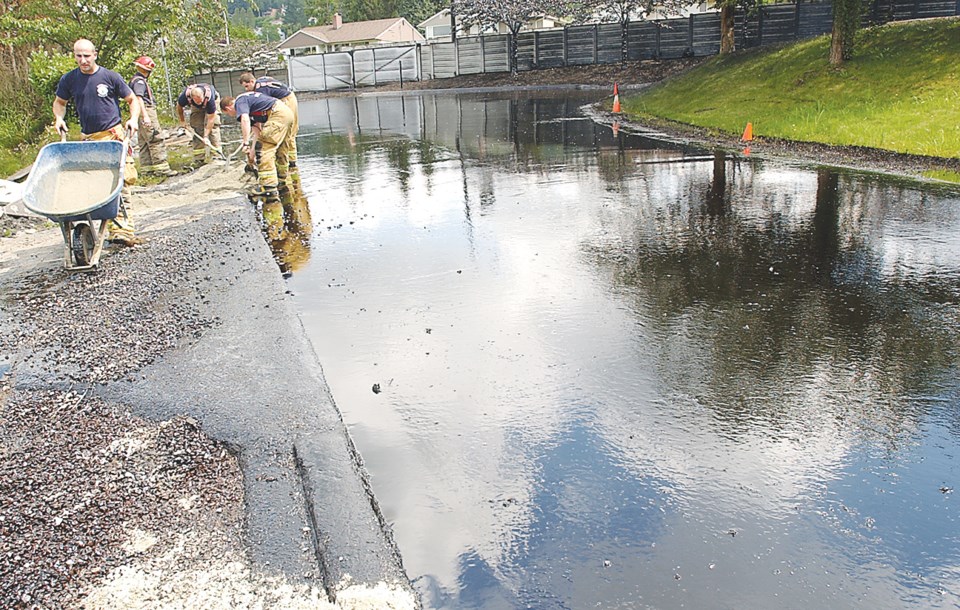
Emergency response
The city sprang into action. A command post was set up on site. The Burnaby RCMP, the fire department and the engineering department’s environment emergency group, says Chu, recognized what needed to be done putting their emergency response training to use.
“The odour of the oil was quite powerful, and it was very difficult for people to even get close to the scene,” he says.
Some of the delay in stopping the flow, the report concluded, was attributed to a mixup in Kinder Morgan’s monitoring centre.
“They closed a valve (at the dock) that should not have been closed, and they left a valve open that should have been closed which was at the tank farm terminal,” says Chu.
“That took a while for them to realize the errors and the mistakes, and when they applied the correct procedures a lot of the homes were already covered with oil and it had started flowing down the streets and down the storm drains into the inlet.”
Command centre set up
Kinder Morgan established a command centre at the Executive Inn on North Road by late that afternoon.
“Certainly, that first night, you’re reacting to the incident as it’s occurring but then you’re developing plans for going forward,” says Hadden, who acted as project manager for the cleanup and remediation and is now director of operations for Kinder Morgan’s Western Canadian region. “We spent late into that night developing plans for the next day.
“Initially, your priorities are obviously the safety of the public, and safety of personnel – public and responding personnel. After that, certainly minimizing the impact to the environment.”
Residents evacuated
An estimated 225 residents were affected directly or indirectly and, like Hatch, were advised to leave the area. A reception area was set up at Confederation Park and accommodation arranged, if needed.
According to Kinder Morgan, 101 evacuees belonging to 42 families spent the night of July 24, 2007 somewhere other than home.
Not Toni Maurer. She has lived just below Hatch on Sierra Drive since 1955, raising a son and daughter. The widow had left with her cat, Prussel, but returned that night despite the acrid smell.
“I couldn’t take her anywhere, and I couldn’t sleep in the car, so I slept in the house,” says Maurer, 83. “They said you shouldn’t come back, but I did anyway.
“It probably wasn’t the right decision. But I had to go home, because of the cat.”
Hatch was out of her home for four nights. She wasn’t anxious to be holed up in a motel room on Lougheed Highway with her two kids and Goldie. So she found a couple of neighbours outside of the zone willing to put her family up. “That would have been very difficult to be there in a motel with nothing.”
Other neighbours, she says, couldn’t return for months because they happened to have their windows open when the oil started spewing, contaminating the interiors of their homes.
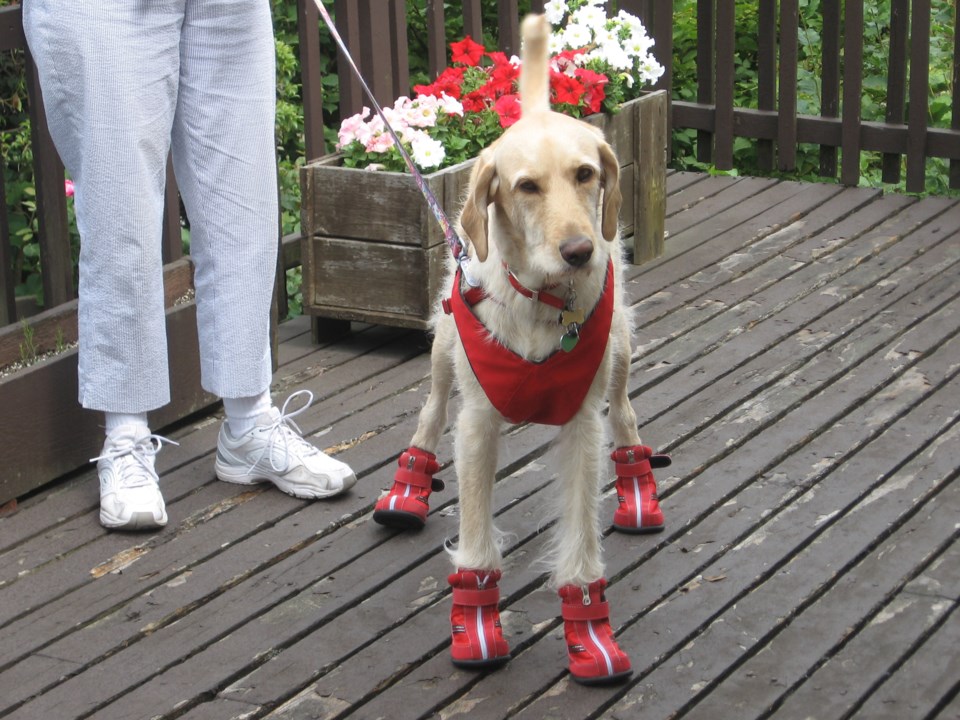
When her family did return, Hatch had to buy Goldie shoes because of the oil on the ground. “Dogs don’t like (wearing shoes),” says Hatch. But Hatch had to because every time Goldie went outside to do her business she’d track oil into the house.
Shore birds affected
The TSB report said: “The crude oil seeped into the surrounding soil, storm drains, and sewer lines. The Barnet Highway was closed for several days. Moving through the storm drain system, the crude oil eventually reached the marine waters of Burrard Inlet where it began to spread further into the inlet through wind and tide action. Burrard Inlet’s marine environment and approximately 1,200 metres of shoreline were affected by the crude oil spill. A number of shore birds were contaminated after coming into contact with the oil.”
Red Zone
Hatch was on the outer edge of what was called the Red Zone, about a 100-metre radius around the rupture encompassing homes on both sides of Inlet.
For several months, Hatch had arborists, landscapers, health researchers, insurance adjusters and bureaucrats tramping on her property. Her soil and grass was removed and replaced. Most of her plants were taken away or severely pruned.
“Everything that’s probably on my property is now new,” she says.
Three arborists trimmed a lot of oily branches off the eight huge evergreens along her front fence, but they weren’t removed. The cedars that stretch to the sky are actually on city property and serve as a sound barrier from the heavy and steady vehicular traffic on Inlet Drive. “That would have been quite a project,” admits Hatch of removing the trees.
Most of the work was carried out by contractors hired by Kinder Morgan. After getting new dirt, sod and plants, a worker showed up to remove and replace her gutters. She was distressed when he started throwing the old gutters, still containing oil, on her new, clean lawn and remediated dirt.
Hatch says it took a couple of years to make sure the remediation was safe.
Maurer didn’t have her soil replaced, but crews came and mowed her lawn three times. A cleaning crew gave her a sprayer with a special solution so she could do the work herself because she and her husband had run their own janitorial and cleaning company. “It was terrible,” she says of the mess.
Her biggest worry was saving a precious grapevine on the south side. She was happy to see it grow back the next summer. What she wasn’t happy with was not having her red aluminum roof replaced when several others had their shingled roofs get a makeover.
Overall, Hatch was pleased with the way Kinder Morgan and its contractors worked to restore her property.
Her insurance company, however, was a different matter when it came to the house.
“Some people in the neighbourhood, I know they had their insurance company walk away from them, and Kinder Morgan paid for them,” she says. “(The adjusters) really didn’t know what they were doing, I could tell by their conversations. It’s not their fault, they’re usually dealing with fire or flood. They’re not usually dealing with oil.”
Hatch became her own bureaucratic watchdog. For one, the teacher got an education in remediation hierarchy. She found out who looks over the companies doing the work. Then she discovered there was even another bureaucratic layer above that.
“All of this I ended up having to do myself. I was the one that had to deal with all the workers that came. You never knew when they’d come; they’d arrive just out of the blue,” she says. “I always had to be vigilant, I couldn’t just say A-OK, everything’s going to be fine. I had to do my own work in order to protect my property, my children, my dog.”
She estimates it took about 30 months to get the physical property back to its original state. “But your sense of safety, that was shattered.”
Published reports say Kinder Morgan spent $15 million in remediation costs and millions more for personal property damage. Kinder Morgan says eight residential properties were classified as being heavily oiled, 15 as moderately oiled and 21 as lightly oiled.
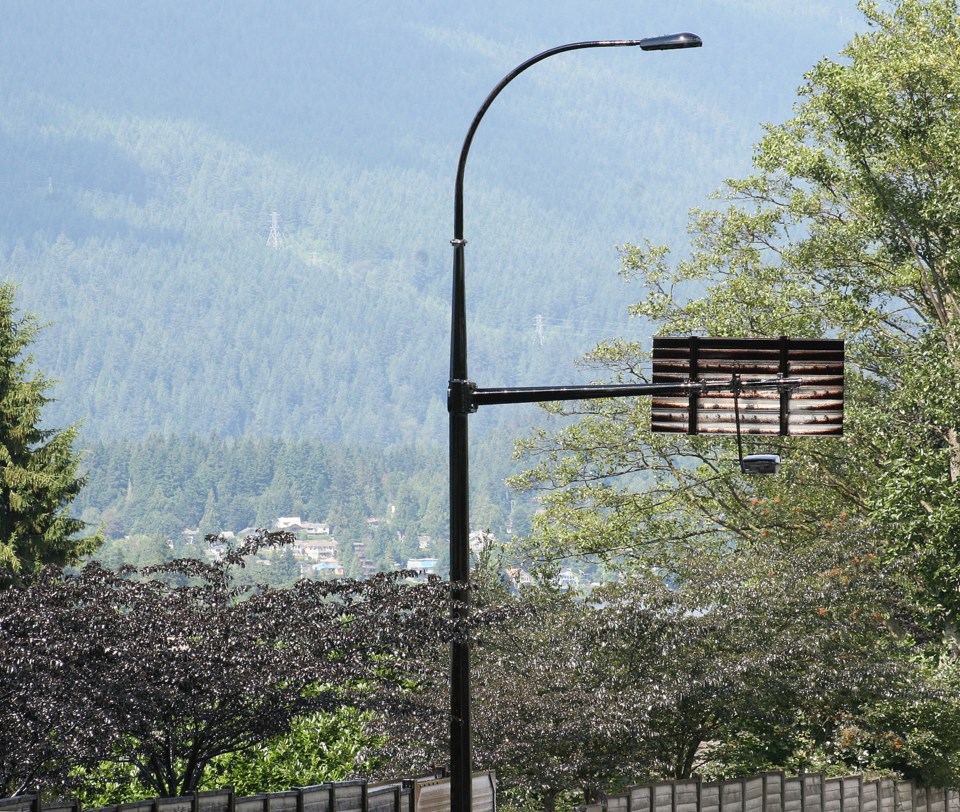
‘Costs were significant’
Hadden managed the cleanup for about a year before becoming the company’s manager for damage prevention and public awareness.
“Certainly, the costs were significant, and we aren’t going to not do anything because the costs are significant,” says Hadden. “We certainly don’t expect anybody else to be out of pocket, or not end up being whole after an incident like this. We were there doing everything it took getting the neighbourhood to the way it was, or even better. We committed to that very early, and I think we followed through with that.
“Certainly, initially, we weren’t worried about blame. Incident investigations can happen later on. … Figuring out who paid, we worried about later.”
Hadden says the spill was relatively small compared to other North American incidents. But, as real estate agents say, it was all about location, location, location.
“Because of its location, it certainly had huge impacts,” he says. “Because the oil itself got into the storm drain system and then into the inlet, it then became a marine spill.”
Blame game begins
The blame game began almost immediately and continued for years. The Transportation Safety Board’s report basically concluded it was a combination of miscommunication, false assumptions, and out-of-date maps and drawings that led to the disaster.
“TSB did a very thorough investigation, and their findings are very accurate,” says Chu.
The report noted the excavator bucket struck the pipe five times with enough force to leave gouge marks. “Any of the five impacts, with two of these impacts leaking oil, could have alerted the on-site supervisors that there was a problem and that an underground structure had been struck.”
Chu, however, doesn’t fault the guy at the controls.
“I sympathize with the machine operator because it was a very large-sized excavator. It was a deep excavation, and when you’re sitting in that excavator there’s very little opportunity to see what’s underground,” says Chu. “You dig by feel, and you go by the drawings because if the drawings are showing you have a clear path to excavate, your job is to put your bucket down to take out the soil. You may run into boulders, you might run into big rocks, but that’s the nature of excavation.”
Chu says that, in those circumstances, the excavator operator needs to have someone standing over the trench to look where the equipment is digging to make sure it isn’t encountering something unusual.
Kinder Morgan, Surrey-based B. Cusano Contracting Inc. and R.F. Binnie Associates of Burnaby pled guilty in October 2011 to introducing waste into the environment causing pollution under the Environment Management Act.
The three were ordered to pay a fine of $1,000 each and to contribute $149,000 into a B.C. environmental trust fund. Kinder Morgan was ordered to contribute $100,000 to the B.C. Common Ground Alliance to identify anyone digging near a pipeline and to fund DigSafe B.C. workshops.
“The positive thing that flowed, if there’s anything positive of this incident, is that corrective measures were put into place to remedy any deficiencies such as the record management system for the pipeline, and also the emergency procedures, inspections and future works requirements within the oil pipeline corridor,” says Chu. “They went through a mountain of information to come to their conclusions, and I think they were right on.
“It really emphasized the importance to have accurate (information) to reflect the location of the facility.”
Fundamental changes
Kinder Morgan made some fundamental changes to its organizational structure by forming the Pipeline Protection Group, which is focused on protection of the pipeline. It brought several company departments together to create a department that works solely on damage prevention and public awareness.
“Third-party damage to pipelines is certainly one of the biggest risks to pipeline safety and the public’s safety,” says Hadden. “It’s also one of the most preventable type of incidents to pipelines. Our biggest takeaway was realizing we could do a better job in managing third parties working around our pipeline systems.
“The ask from the highest levels of our company was, ‘How can you assure us that this type of thing will never happen again?’ So that was our challenge and we came up with this new model.
“Since then we’ve had no significant third-party incidents. Of course, it’s always continuous improvement. We certainly aren’t going to rest on our laurels. Our systems are much better today than they were 10 years ago.”
Residents moving on
Although it’s a decade later, Hatch says many residents just want to put the rupture behind them.
“A lot of people don’t want to (talk about it),” she says. “There are a few people who actually just want to forget it, they don’t want to think about it anymore, they just want it to go away. Then there’s others, like me, who are still learning more and still try to help, if we can, to raise awareness and educate. For me, I never realized the bigger picture of global warming, and that’s all been part of what I’ve learned for myself.”
Just down the back lane from her place, Hatch has a neighbour who is moving to the West Kootenays and is representative of a different attitude. A lot of oil went down the lane’s storm drain before it got to the house he owned, so it only suffered a “salt and pepper” look to it.
“You can’t stress over those things. They’ll clean it up, they’ll fix it,” he shrugs, declining to give his full name.
Two other families contacted by the NOW who had their homes sprayed by the oil politely declined interviews. Some don’t live there anymore, but that’s not necessarily due to the spill.
On the rupture’s sixth anniversary, Hatch organized a gathering at Westridge Park. She called it a rally, which caused some uneasiness. “They were nervous to come,” says Hatch.
For the 10th anniversary, there will be a picnic this Sunday, 1 to 3 p.m., at the park.
Love for neighbourhood
Maurer, 83, loves the neighbourhood and wasn’t about to move out.
“My kids grew up here. It was the neighbourhood I knew, and we had good neighbours. At my age, you just can’t take off and leave,” says Maurer. “I didn’t think anybody would buy it either at that time.”
But the fear of property values plummeting didn’t materialize in reality.
A graph from the Real Estate Board of Greater Vancouver (REBGV) shows the area’s prices mirrored the ups and downs of the Lower Mainland housing market.
“It had a very slight impact, but it primarily followed the same market as elsewhere,” says Jill Oudil, REBGV president and a longtime Burnaby Realtor. “It recuperated from whatever slight dip there was.
“Sales will always continue. Values can slightly change in different markets in different pockets, but, overall, the entire of Metro Vancouver has always somewhat followed the same path. And Burnaby is always desirable as well.”
The spectacular vistas homes in Westridge possess will always create desirability, adds Oudil.
“Views are primary. It doesn’t really matter what area you’re in, from Vancouver to Maple Ridge, I mean everywhere, views are of utmost importance to purchasers.”
Health questions
Since the rupture, Hatch has survived a breast cancer scare. During her treatment she was told there is a higher proportion of residents in the area with cancer. But, she admits, it’s difficult to determine how much of a role, if any, the rupture played in those findings. After all, Westridge has had a cluster of refineries nearby in the past and the neighbourhood is close to a heavily used commuter route.
After the rupture, Fraser Health worked with the National Energy Board, the City of Burnaby, the B.C. Centre for Disease Control and Kinder Morgan and their consultants to establish the criteria for oil removal and remediation to help protect residents.
Fraser Health concluded there was no post-remediation health hazard from the spilled oil, based on information provided by Kinder Morgan and its consultants, and does not expect any significant ongoing exposure risk, according to spokesperson Tasleem Juma.
As for the environment, a study by Stantec commissioned by Kinder Morgan in 2012 says a long-term monitoring program that began in 2008 shows “recovery endpoints” for water, intertidal sediment, crabs, subtitle sediment and fucus (brown algae) have been met. But “there are residual levels of contamination in mussels that have not yet met the agreed upon endpoint levels.”
Debate continues
There’s no denying the rupture has had a big impact on debate over Kinder Morgan’s Trans Mountain expansion. Spokesperson Ali Hounsell noticed it when she first started working on the pipeline expansion project in 2012.
“It was a question and topic that was brought up quite frequently when we first started to propose the expansion, particularly when we were in Burnaby. It was still relatively fresh in people’s minds,” says Hounsell.
The concern is why, she says, Kinder Morgan is proposing to go through Burnaby Mountain instead of doubling the current route through heavily populated neighbourhoods.
“Yes, it is more of a challenge when you’ve got infrastructure going through busy residential and municipal areas, but some of the steps we have put in place, you can never take human error entirely out of it, but you can certainly put processes and protocols in place to minimize the risk as much as possible,” says Hounsell.
Keeping watch
One reason Hatch has stuck around is to help protect her community.
When Kinder Morgan announced its expansion plans a few years ago, she didn’t hesitate in learning more and joined Burnaby Residents Opposed to Kinder Morgan Expansion.
In her mind, the issue has brought up the ghosts of 2007.
“It does, because that was human error. I know they are trying to make this as safe a facility as possible, but human error often plays into mistakes being made,” says Hatch. “Whether you agree with it or not, it isn’t a good thing to have in a densely populated neighbourhood.”
Chu and the City of Burnaby are strongly opposed to the proposal. He acknowledges the company has sophisticated systems that can detect the rate of oil flow anywhere along the pipeline that help to avert disaster.
“But despite state-of-the-art technology, human errors do occur. And human errors in record drawings and emergency procedures are something that you see. Not because of the failure of the system technology per se, but it was one error, that led to another, which resulted in significant damage to the environment and to the neighbourhood,” he says.
“It was a wake-up call. Not that we weren’t worried about pipeline safety before, but it even heightened the awareness of the pipeline in the urban environment.
“We already have one pipeline that we have to accommodate. By doubling the pipeline capacity, we also create additional risk. Even though they claim the pipeline safety record is good, nevertheless there are risks. Even though the probability is low, the possibility is there.”
